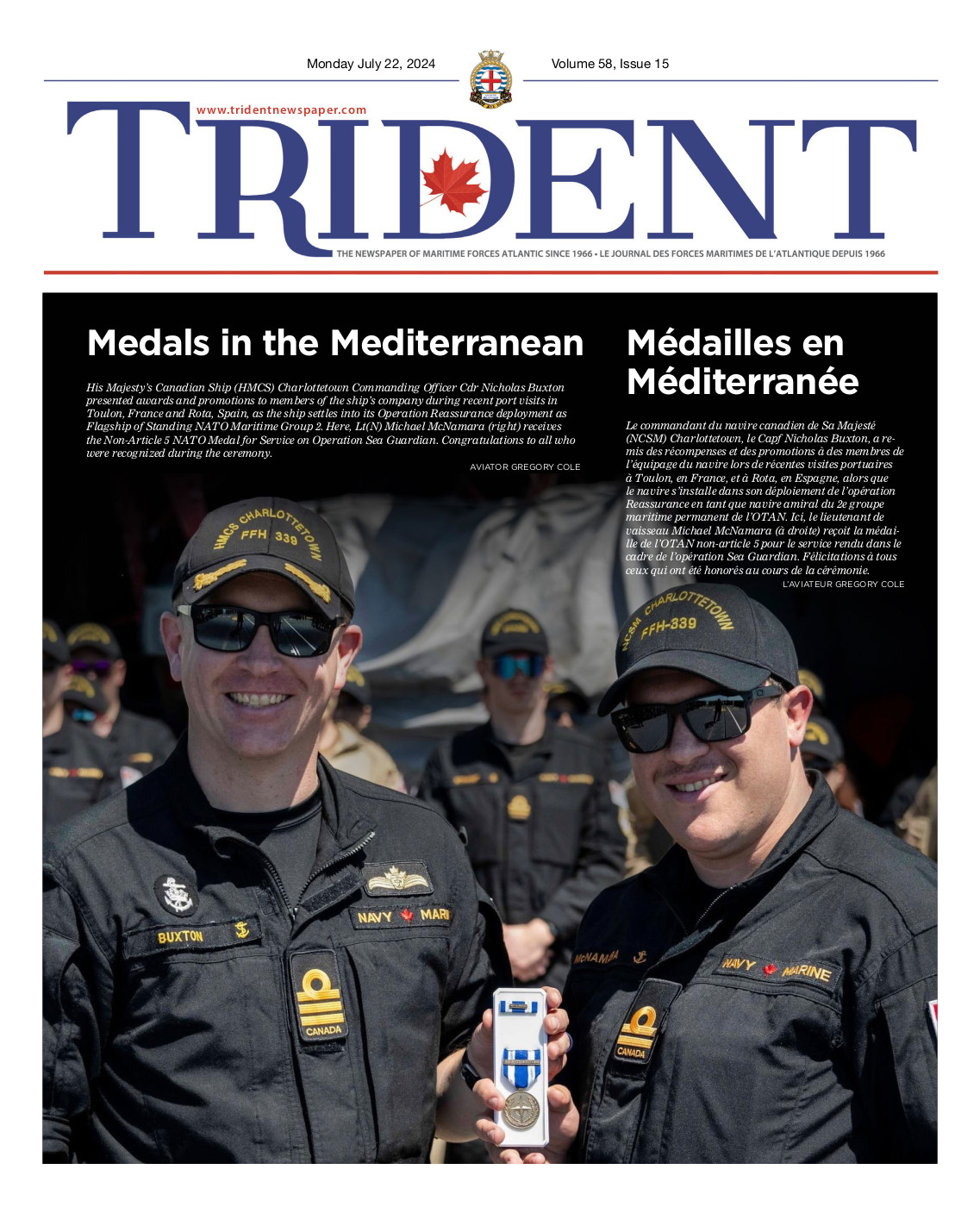
The RCN in St. John’s: A rich history and lasting legacy
By Margaret Conway,
Affairs Publiques de la BFC Halifax
On July 13, 2018, CFB Halifax and the Royal Canadian Navy (RCN) handed over command authority of Canadian Forces Station (CFS) St. John’s to the 5. Canadian Division Support Group of the Canadian Army (CA). Here’s a look back at the RCN’s presence in the city of St. John’s through times of war and peace which resulted in an everlasting bond between Canada’s navy and the people and province of Newfoundland.
History
The RCN has been connected to the city of St. John’s and the province of Newfoundland for over a century dating back to the First World War.
In 1910, the heavy protected cruiser HMCS Niobe was purchased by Canada from the Royal Navy (RN) for use as a sovereignty patrol and training vessel by the RCN (known then as the Naval Service of Canada). In September 1914, Niobe joined the war effort, traveling to the St. John’s Harbour in the Dominion of Newfoundland, then a British colony, to pick up 107 sailors from the Royal Naval Reserve Newfoundland Division who had been training on British ship HMS Calypso. Niobe’s combined crew of Canadian and British sailors, including the Newfoundland reservists, patrolled the waters from New York and Boston to Iceland for enemy cruisers and Merchant vessels.

PHOTO COURTESY OF THE NAVAL MUSEUM OF HALIFAX
As the Second World War began, the RCN’s presence in St. John’s grew: Canada’s sailors were called on to help protect merchant ships traversing the Atlantic Ocean to deliver essential North American supplies and military personnel to Britain. RCN warships and sailors comprised over half of the escort vessels defending merchant ships from German U-boats. The Battle of the Atlantic (BOA), as it became known, was the longest continuous military campaign of that war.
The St John’s Harbour became a key geographic location during the BOA, as its proximity to Europe allowed the RCN, RN and allied navies to remove a dangerous protection gap that had left Merchant vessels at the mercy of the U-boats. Merchant ships from Halifax would now be escorted to St. John’s and turned over to the Newfoundland Escort Force (NEF), a combination of RCN and RN ships that, given their location, could now sail further in order to perform a direct hand-off to allied vessels in the mid-Atlantic.
With the creation of the NEF, the city of St. John’s became a busy naval hub during the Second World War. On shore, clubs, messes and recreation camps offered social refuge to naval and merchant sailors who had come together in a time of great conflict. The St. John’s-based Crow’s Nest, originally known as the Seagoing Officers’ Club when it was established by then RCN Captain Rollo Mainguy, still exists today.
Despite the many tragic losses that occurred while battles raged throughout the cold North Atlantic, the war had created what would become a lasting bond between the people of Newfoundland and the RCN.
Canadian Forces Station St. John’s
Post-war, the RCN maintained its presence in St. John’s, eventually taking command of CFS St. John’s upon its creation in the late 1960s. The property on which CFS St. John’s was established had originally been developed as Fort Pepperell, a United States military base built in 1941 through a lend-lease agreement with the United Kingdom. When the American base closed in 1960, the land was transferred back to the Crown and on June 21, 1968, CFS St. John’s was officially opened for business. Under RCN command for the last 50 years, the station has provided operational and logistical support to various lodger units throughout the province and essential support to naval ships visiting St. John’s. The station was housed in multiple war-era buildings until 2014 when the state of the art Surgeon LCdr W. Anthony Paddon Building was completed.
Dedication of naval artifacts
In the fall of 2017, Rick Sanderson, director of the Naval Museum of Halifax, was asked to curate a collection of naval artifacts to display at CFS St. John’s with help from the station’s Commanding Officer (CO), LCdr Gerry Parsons. The collection, meant to serve as a lasting reminder of the RCN’s enduring relationship with St. John’s and the province of Newfoundland, was revealed at a dedication of naval artifacts ceremony held on July 12 at CFS St. John’s.
“This room, these displays are dedicated to the people of St. John’s,” explained LCdr Parsons, gesturing toward the various historical items and photographs placed along the perimeter of the room.
The wheel from HMS Calypso, encased in a large glass display, was the most prominent piece in the collection. Calypso, an RN corvette, served as the official training ship for members of the Royal Naval Reserve (RNR) Newfoundland Division in the early 1900s. The Calypso display also included a ceremonial launch kit from HMS Calypso dating back to 1883 along with a ditty box belonging to RNR Newfoundland Division Member George Chesley Allen.
Other elements of the naval display included four panels of historical imagery highlighting the naval presence in St. John’s throughout the past century. The black and white prints ranged from photos of warships in the St. John’s Harbour to an image of a friendly basketball game held between sailors from HMCS Cabot, St. John’s’ Naval Reserve Division, and the Memorial University men’s basketball team. Photos of former American installations such as Argentia Naval Air Station and Fort Pepperrell were also included in the display.
On hand to witness the dedication ceremony were members from the station and large contingent of local guests and friends of the station who would be attending the CFS St. John’s 50th anniversary naval mess dinner held later that same evening. Many of these guests would return to the station the next morning as well to witness a particularly significant Change of Command ceremony.
CFS St. John’s Change of Command
“Now, before we get started, I’d like to survey the crowd. Is anyone looking to buy a house?”
It was a Change of Command ceremony that began more like a stand-up comedy routine, as LCdr Gerry Parsons, outgoing Commanding Officer (CO) of CFS St. John’s, posed this question to a room full colleagues, family members and community partners. There was instant laughter from the crowd, a group comprised largely of military members who are all too familiar with the buying and selling of homes that occurs during the busy posting season.
Despite his playful demeanor, LCdr Parsons was prepared for a very bittersweet day personally, but also a day of great change for the RCN. It was July 13, 2018, and after four years as the CFS St. John’s CO, LCdr Parsons was saying farewell to his command post and to the people and place that he’d come to appreciate so fully.
In his departing address, he detailed some of the highlights during his years in command. The 75th anniversaries of the Bell Island U-Boat attacks, the Atlantic Charter and the Crow’s Nest were mentioned along with CUTLASS FURY 2016, a joint maritime training anti-submarine warfare event that saw eight warships from five nations make a port visit to St. John’s.
LCdr Parsons praised the military and civilian workforce at the station for its enduring professionalism, giving personal thanks to his internal command team, PSP, SISIP, the MFRC and the CFB Halifax Base Commanders who held command during his tenure as station CO. “If you don’t have your people, you don’t have anything,” he remarked, concluding his address soon after with a formal welcome and some words of encouragement for incoming CO Maj Robert McKenzie. “Rob, you’ve got a good ship here. They will continue to carry the torch.”
CFS St. John’s Transfer of Command Authority
A routine military Change of Command ceremony follows a fairly predictable sequence. The incoming and outgoing parties deliver speeches, the Presiding Officer adds his or her remarks and the command scrolls are signed, among other traditions. All of these elements were present at the CFS St. John’s Change of Command on July 13.
On this particular occasion, however, both LCdr Parsons and Maj McKenzie were involved in a sword ceremony. During the ceremony, LCdr Parsons picked up and handed a naval sword to the senior RCN representative and the ceremony’s Presiding Officer, Cmdre Darren Garnier, after which Maj McKenzie received an army sword from the senior CA representative and Deputy Commander of 5. Canadian Division, BGen James Camsell. This giving and receiving of swords was a significant departure from the standard sequence of events as it signified the transfer of command authority of CFS St. John’s from CFB Halifax (RCN) to 5. Canadian Division Support Group (CA).
For much of its 50-year history under RCN command, CFS St. John’s has been home to six Canadian Army Reserve units that have occupied the majority of the office and training facilities. Transferring command authority of the station from CFB Halifax (RCN) to the 5th Canadian Division Support Group (CA) will enable these Army Reserve units to receive the administrative and logistic support necessary to implement mission specific capabilities that have been assigned to them through the Strengthening the Army Reserve initiative, part of the Strong, Secure, Engaged defence policy.
Cmdre Garnier, who himself held command of CFS St. John’s from 2006 to 2007, understood the significance of the sword ceremony very well. “The men and women who will lead this station in the future are acutely aware of its history,” he remarked, alluding to the station’s 50 years of operation under the care and direction of the RCN and the Canadian Navy’s enduring relationship with the people of Newfoundland. Despite what he described as a day “filled with lots of emotion for many,” Cmdre Garnier spoke with reassurance in his address, confirming what is already known to many: that the RCN has been connected to the city of St. John’s and surrounding communities for over a century, and that the station’s transfer to CA command in no way diminishes the deep connection that exists between the RCN, the city of St. John’s and the province of Newfoundland.
Cmdre Garnier closed his remarks by thanking LCdr Parsons for his excellent work on behalf of the RCN and the CAF and wishing Maj McKenzie the best as he assumed command of the station. He then pointed to the stunning vista of land and sea beyond the room’s full wall of windows that reveals a narrow waterway connecting St. John’s to the North Atlantic. He reminded the incoming CO and the 5. Canadian Division representatives on-hand that to move forward and progress was essential to the continued success and CFS St. John’s and that, despite the challenges that may lay ahead, there is always a new day.
“The sun always rises over Quidi Vidi through that little gut.”





